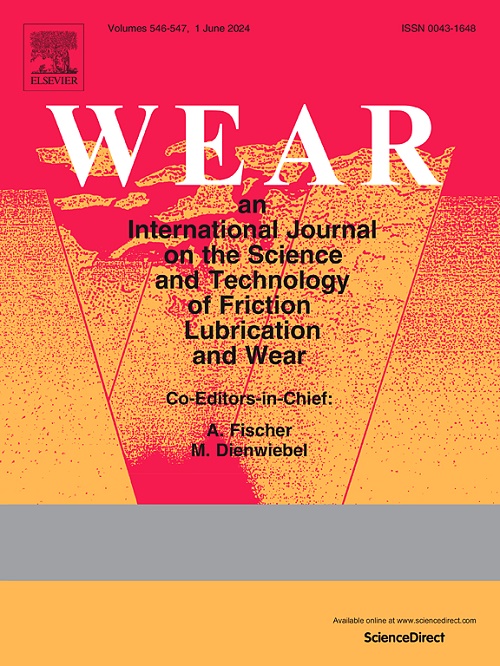Critical parameters on sliding wear behavior in abradable sealing coatings
IF 5.3
1区 工程技术
Q1 ENGINEERING, MECHANICAL
引用次数: 0
Abstract
The abradability of ceramic-based abradable sealing coatings (ASCs) is exhibited as a sliding wear. We constructed a formula for the dimensionless function of wear rate based on the theorem. The interaction coefficient , the actual intrusion depth , and the porosity are the main variables influencing wear rate. The abradable process of the sealing coating was investigated by numerical finite element simulations and wear experiments. It was observed that the intrusion depth and wear rate show a trend of increasing and then decreasing with increasing porosity, while a similar trend is shown with wear rate. Both strain energy () and friction work () affect the wear rate. The wear rate of low-porosity coatings largely depends on strain energy, while that of high-porosity coatings is mainly influenced by friction work. This study has extracted key parameters that affect the high-temperature wear of sealing coatings, providing theoretical and experimental evidence for the preparation and performance assessment of coatings.
可磨性密封涂层滑动磨损性能的关键参数
陶瓷基可磨性密封涂层的耐磨性表现为滑动磨损。基于π定理构造了磨损率的无量纲函数表达式。影响磨损率的主要变量是相互作用系数μ、实际侵入深度hr和孔隙度pASC。通过数值有限元模拟和磨损试验研究了密封涂层的磨损过程。随着孔隙率的增加,侵入深度和磨损率呈现先增大后减小的趋势,磨损率也呈现出相似的趋势。应变能(Wn)和摩擦功(Wf)都影响磨损率。低孔隙率涂层的磨损速率主要取决于应变能,而高孔隙率涂层的磨损速率主要受摩擦功的影响。本研究提取了影响密封涂层高温磨损的关键参数,为涂层的制备和性能评价提供了理论和实验依据。
本文章由计算机程序翻译,如有差异,请以英文原文为准。
求助全文
约1分钟内获得全文
求助全文
来源期刊

Wear
工程技术-材料科学:综合
CiteScore
8.80
自引率
8.00%
发文量
280
审稿时长
47 days
期刊介绍:
Wear journal is dedicated to the advancement of basic and applied knowledge concerning the nature of wear of materials. Broadly, topics of interest range from development of fundamental understanding of the mechanisms of wear to innovative solutions to practical engineering problems. Authors of experimental studies are expected to comment on the repeatability of the data, and whenever possible, conduct multiple measurements under similar testing conditions. Further, Wear embraces the highest standards of professional ethics, and the detection of matching content, either in written or graphical form, from other publications by the current authors or by others, may result in rejection.
 求助内容:
求助内容: 应助结果提醒方式:
应助结果提醒方式:


